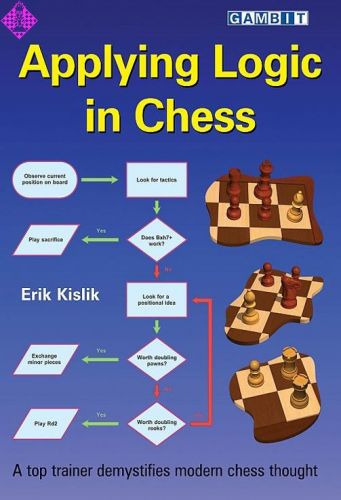Applying Logic in Chess
320 Seiten, kartoniert, Gambit, 1. Auflage 2018
Is chess a logical game? What constitutes an advantage in chess? How can we set problems and create psychologically difficult situations for the opponent? These are big questions, and Erik Kislik tackles them and others head-on in this thought-provoking, thoroughly modern, and original work.
He answers the first of those questions with a resounding ‘yes!’. His assessments focus on concrete points: pawn-structure, material imbalance and compensation. Even though the analytical proofs may be complex, he repeatedly shows that these elements are the keys to evaluating positions and forming plans.
As the trainer of players ranging from high-level grandmasters to average club-players, Kislik is very strong on providing practical guidance on topics such as how best to use chess software, choosing hardware, getting psychologically ready for a game and preparing for specific opponents. He is always willing to boldly state his views, even when they run contrary to conventional chess wisdom.
“I was excited by this book because of the way all of the ideas are intertwined and you get very concrete advice ... Everything is applicable and it is easy to see how it applies to the real world.” – from the Foreword by GM Hjörvar Steinn Gretarsson.
Erik Kislik is an International Master originally from California who lives in Budapest. He is an expert in computer chess and one of the most in-demand chess trainers on ICC. He has coached many grandmasters and assisted a number of elite players with their opening preparation.
| Gewicht | 610 g |
|---|---|
| Hersteller | Gambit |
| Breite | 17,2 cm |
| Höhe | 24,8 cm |
| Medium | Buch |
| Erscheinungsjahr | 2018 |
| Autor | Erik Kislik |
| Sprache | Englisch |
| Auflage | 1 |
| ISBN-13 | 978-1911465249 |
| Seiten | 320 |
| Einband | kartoniert |
005 Symbols
006 Foreword by GM Hjörvar Steinn Gretarsson
008 Introduction
014 1 Starting from the Beginning
014 Piece Values
026 Interpreting Chess Rules and Ideas Taught to Beginners
040 The Allure of Genius and Glamorizing the Past (Tal Syndrome)
044 What Should You Be Trying to Do When You Play Chess?
045 What Should You Ask Yourself During a Game?
051 2 Levels of Chess Skill
051 What are the Main Stages of Chess Improvement?
059 General Improvement
066 3 Prioritizing Your Chess Undertakings
066 Playing
069 Analysis of Your Games
070 Training
084 4 Elements of Chess Strength
085 Concrete Knowledge
085 Pattern Recognition
087 Calculation
091 Candidate Moves
102 Positional Understanding
103 Logic
106 5 Different Types of Training
106 Tactics
107 Endgames
117 Historical Games and Keeping Up with Chess ‘Culture’
120 Blitz
122 Books
128 Analysing and the ‘Most Obvious Move’ Principle
131 What Should I Walk Away from My Games With?
131 What Should I Use a Coach For?
137 6 An Approach to Evaluating Positions
137 What is an Advantage?
149 Advantages for Free
154 Conditional Equality
160 Compensation and Complicated Cases
176 7 Is Chess a Logical Game?
182 8 Engines in Chess
194 Analysing Positions with Computers
200 9 Analysing Your Games and Self-Improvement
225 10 Metagame Opening Strategy
225 Metagame Thought
233 Planning an Opening Repertoire
250 Opening Questions to Ask
253 Structures and Openings
269 11 Losing Consistency
284 12 Critical Moments
295 13 Sports Psychology in Chess
307 14 Theory in Practice
315 Conclusions and Recommendations
318 Index of Names

